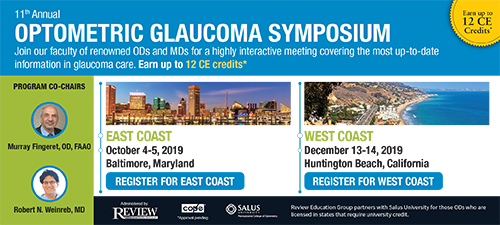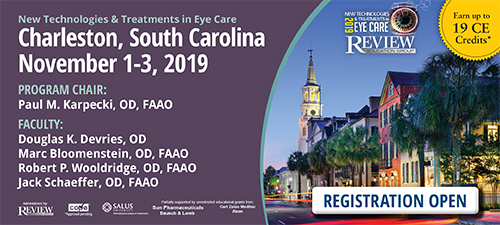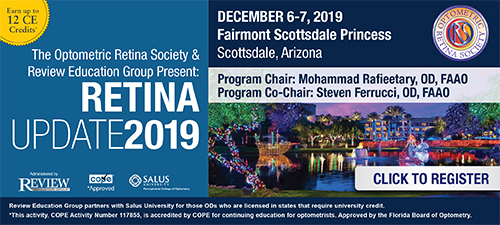
A
weekly e-journal by Art Epstein, OD, FAAO
Off the Cuff: DEWS II Revisited – With Special Thanks to Dr. Kelly Nichols
It’s been a little more than two years since the release of the DEWS II report. As someone who spends a good part of his time thinking, treating and talking about dry eye and the ocular surface and tear film, the DEWS II report stands as one of the most valuable resources I have. I am certainly not alone. For anyone interested in dry eye and ocular surface disease, DEWS II is a foundation for greater understanding of this constellation of complex and often confusing diseases. The work is comprehensive, but to me, the current definition continues to stand out as its single most important contribution. “Dry eye is a multifactorial disease of the ocular surface characterized by a loss of homeostasis of the tear film, and accompanied by ocular symptoms, in which tear film instability and hyperosmolarity, ocular surface inflammation and damage, and neurosensory abnormalities play etiological roles.” The addition of homeostasis to the definition signals a groundbreaking and, I suspect, still-much-underappreciated shift in our understanding of how the ocular surface interacts with itself, the body and its surrounding environment. To accept the importance of homeostasis—the unceasing determination of the body to maintain function and balance regardless of external or internal challenges, reflects the critical importance of the eye and sight to human existence. It also infers that the system is both dynamic and centrally managed. While many of us still view dry eye as a static problem fixed in time, this definition opens our eyes to the dynamic, constantly changing, elegant beauty and complexity of a system in a constant state of flux. Homeostasis describes the constant struggle for balance and function of our ocular microenvironment despite the challenges posed by the surrounding macroenvironment. Failure results in tear instability and loss of protection and function. What of osmolarity? Shifts in osmolarity are either a result of or a contributor to the loss of homeostasis. In turn, they either reveal or lead to dysfunction. I believe the former is more likely. Our understanding of neurosensory abnormalities is still in its infancy. Clearly, a system with the importance of sight would be allocated a massive amount of neural horsepower. Anything that interferes with neural control, including iatrogenic causes or surface damage to neural receptors, could have significant functional and homeostatic consequences. Finally, the chicken or egg conundrum of inflammation. What I see in the office every week reaffirms that inflammation represents a last resort for the ocular surface environment. When homeostatic control systems fail, the body reverts to inflammation, its most rudimentary defense and repair system. However, as every clinician quickly discovers, inflammation is difficult to control. So, as I see it, inflammation is usually a consequence of homeostatic dysfunction, rather than its direct cause. Regardless, it’s one that often needs to be addressed. So why is all of this important? As I think about the past years of my practice, which is essentially now limited to dry eye, communication stands out as the single most important tool for successfully managing even the most severe cases. Knowledge is empowering and reassuring to patients who often feel unheard and abandoned. Taking the time to explain things forces you to understand them. As I struggled with how best to share what I’ve figured out with you, I realized that the DEWS II definition provided the best foundation. If you haven’t yet read the DEWS II report you should. You also might want to have your patients read the patient summary. Knowledge is power, and DEWS II is knowledge.
|
|||||
 |
||
| Altered White Matter Structure in Auditory Tracts Following Early Monocular Enucleation | ||||
Similar to early blindness, monocular enucleation (the removal of one eye) early in life results in crossmodal behavioral and morphological adaptations. Previously it has been shown that partial visual deprivation from early monocular enucleation results in structural white matter changes throughout the visual system (Wong, et al., 2018). The current study investigated structural white matter of the auditory system in adults who have undergone early monocular enucleation compared with binocular control participants. Researchers reconstructed four auditory and audiovisual tracts of interest using probabilistic tractography, and compared microstructural properties of these tracts to binocularly intact controls using standard diffusion indices. Although both groups demonstrated asymmetries in indices in intrahemispheric tracts, monocular enucleation participants showed asymmetries opposite to control participants in the auditory and A1-V1 tracts. Monocular enucleation participants also demonstrated significantly lower fractional anisotropy in the audiovisual projections contralateral to the enucleated eye relative to control participants. Partial vision loss from early monocular enucleation resulted in altered structural connectivity that extended into the auditory system, beyond tracts primarily dedicated to vision. |
||||
SOURCE: Wong NA, Rafique SA, Moro SS, et al. Altered white matter structure in auditory tracts following early monocular enucleation. Neuroimage Clin. 2019;24:102006. |
||||
 |
||
| Relationship Between Vision-Related Quality of Life and Central 10 Degrees of the Binocular Integrated Visual Field in Advanced Glaucoma | ||||
These researchers investigated the relationships between sensitivity loss in various subfields of the central 10 degrees of the binocular integrated visual field (IVF) and vision-related quality of life (VRQoL) in 172 patients with advanced glaucoma. Using the Random Forest algorithm, which controls for inter-correlations among various subfields of the IVF, investigators analyzed the relationships among the Rasch analysis-derived person ability index (RADPAI), age, best-corrected visual acuity (BCVA), mean total deviations (mTDs) of eight quadrant subfields in the IVF measured with the Humphrey Field Analyzer (HFA) 10-2 program (10-2 IVF) and mTDs of the upper/lower hemifields in the IVF measured with the HFA 24-2 program (24-2 IVF). Significant contributors to RADPAIs were as follows: The inner and outer lower-right quadrants of the 10-2 IVF contributed to the dining and total tasks; the lower-left quadrant of the 10-2 IVF contributed to walking, going out and total tasks; the lower hemifield of the 24-2 IVF contributed to walking, going out, dining, and miscellaneous and total tasks; and BCVA contributed more to letter, sentence, dressing and miscellaneous tasks than to others. The impact of damage in different 10-2 IVF subfields differed significantly across daily tasks in patients with advanced glaucoma. |
||||
SOURCE: Yamazaki Y, Sugisaki K, Araie M, et al. Relationship between vision-related quality of life and central 10° of the binocular integrated visual field in advanced glaucoma. Sci Rep. 2019;9(1):14990.
|
||||
 |
||
| Corneal Cross-linking in Thin Corneas: One-year Results of Accelerated Contact lens-assisted Treatment of Keratoconus | ||||
This retrospective study included consecutive patients undergoing accelerated contact lens-assisted cross-linking (A-CACXL) for progressive keratoconus from 2015 to 2017 to evaluate the safety and efficacy of A-CACXL for patients with keratoconus and thin corneas. Patients with a minimum corneal thickness of 400 µm or less after epithelium removal who underwent A-CACXL (9mW/cm2 for 10 minutes, using iso-osmolar 0.1% riboflavin solution and a 90-µm thick, daily disposable bandage soft contact lens) with a follow-up time of 12 months or more were included. The main outcome measures were uncorrected (UDVA) and corrected (CDVA) distance visual acuity and minimum corneal thickness at the last visit. Progression (increase) and flattening (decrease) were defined as a change of 1.00 diopters (D) or greater in maximum keratometry or 1.50D or greater in mean keratometry. Overall, 24 eyes of 24 patients were included with a follow-up time of 18.2 ± 6.3 months and a mean minimum corneal thickness, after epithelial debridement, of 353.13µm. There was a significant improvement in UDVA, maximum keratometry, anterior steep keratometry, anterior astigmatism and posterior astigmatism, with no significant change in minimum corneal thickness. There was a significant improvement in UDVA (0.90 ± 0.63 to 0.64 ± 0.47 logMAR), maximum keratometry (61.20 ± 6.30 to 59.90 ± 5.70D), anterior steep keratometry (55.10 ± 3.90 to 54.50 ± 4.10D), anterior astigmatism (5.50 ± 2.40 to 4.60 ± 2.10D) and posterior astigmatism (0.90 ± 0.40 to 0.80 ± 0.40D), with no significant change in minimum corneal thickness (from 399.8 ± 30.7 to 391.0 ± 43.8μm). Flattening occurred in 45.8% (n=11) and progression in 20.8% (n=5). There were no serious adverse events. Persistent clinically significant stromal haze occurred in one case and completely resolved by six months. There was no significant change in endothelial cell density. In patients with keratoconus and thin corneas, A-CACXL halted keratoconus progression in 80%, led to flattening in 45% and significantly improved UDVA and keratometry values without any evidence of damage to the corneal endothelium or permanent adverse events. |
||||
SOURCE: Antar H, Tsikata E, Ratanawongphaibul K, et al. Analysis of neuroretinal rim by age, race, and gender using high-density three-dimensional spectral domain optical coherence tomography. J Glaucoma. 2019; Oct 9. [Epub ahead of print]. |
||||
 |
||
| News & Notes | |||||||||||||||
B+L Introduces PreserVision AREDS 2 Formula Minigel Eye Vitamins, Announces Six Poster Sessions & ARMOR Data at AAO In addition, the company announced six new scientific poster and clinical presentations, as well as data from the company’s Antibiotic Resistance Monitoring in Ocular MicRoorganisms (ARMOR) surveillance study, during the American Academy of Optometry annual meeting (Oct. 23-27) in Orlando, Fla. The company’s latest product innovations will be featured at booth #801. Learn more. |
|||||||||||||||
J&J Vision Showcases New Data at AAO, Releases Positive Study Findings on Acuvue Oasys with Transitions CLs The company also reported new data from a study of its Acuvue Oasys with Transitions Light Intelligent Technology, which found the benefits of the light adaptive contact lens were deemed highly valued and useful by people who had never worn contact lenses, and that nearly all of the study participants preferred the contact lenses as part of their habitual vision correction. Read more. |
|||||||||||||||
| RightEye Releases Educational Guide on Visual Learning Assessments RightEye LLC released a new educational guide designed to help optometrists realize the benefits of integrating visual learning assessments into their practices. This guide provides tips on different ways that optometrists can expand their service offering with minimal investment. The guide also provides sample revenue models designed to help optometrists understand the business potential for integrating visual learning and reading assessments into their practice. Learn more. |
|||||||||||||||
|
|||||||||||||||
|
|||||||||||||||
|
Optometric Physician™ (OP) newsletter is owned and published by Dr. Arthur Epstein. It is distributed by the Review Group, a Division of Jobson Medical Information LLC (JMI), 11 Campus Boulevard, Newtown Square, PA 19073. HOW TO ADVERTISE |




